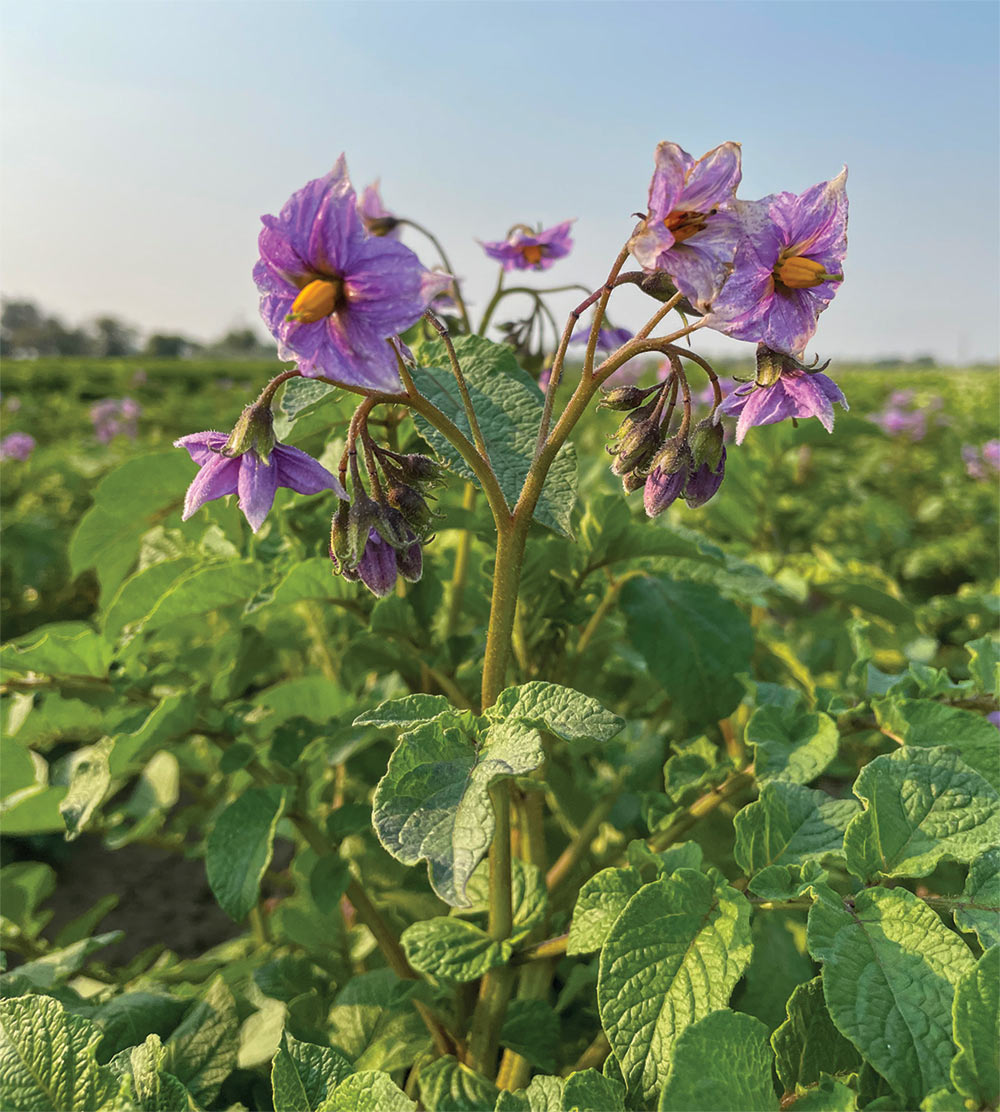

No single strategy consistently reduces PVY incidence from year to year or location to location. As a result, current recommendations are to incorporate multiple tactics. In this article, one of several recommended strategies — use of a crop border — is discussed.
Understanding how PVY is moved is the first step to devising strategies to manage it. PVY is acquired from infected plants and transmitted to healthy ones by aphids. Dozens of aphid species are capable of vectoring PVY, and they do so in a non-circulative, stylet-borne (and non-persistent) manner. Furthermore, an aphid can pick up PVY particles on its mouthpart (stylet) quickly while it probes infected plants in its search for a plant on which it can feed. The virus particles are then rapidly released from the aphid’s stylet as the aphid moves to a new plant and continues to probe. The entire process of taking up the virus from an infected plant and transmitting it to a healthy one can take less than a few minutes, before insecticides can kill the aphid.
Even though potato-colonizing aphids can efficiently vector PVY, the aphids that pose the biggest risk for moving PVY into a seed potato field appear to be those that do not colonize potato, like cereal aphids. These non-colonizing aphids can arrive to potato fields in large numbers while in their winged state. Such immigrating aphids will explore potatoes as they seek their desired plant host.
While they are moving and probing, they introduce PVY into the field, and they can also move PVY that is already in the field. Importantly, an aphid that has acquired PVY loses it after one to a few probes. This seemingly inconsequential fact is important because it means if we can find ways for immigrating aphids to clean off their stylets before entering a seed potato field, we can, in theory, reduce the amount of PVY that is introduced into the field, transmitted to healthy plants, and subsequently translocated to the daughter tubers.
Taking advantage of aphid behavior and how they acquire and transmit PVY is where border crops can play a role. Aphids tend to land on edges of fields first, because they are attracted to the contrast between plants and soil, and small wind eddies at the crop-soil interface make landing feasible. Plants along the edges of fields, then, may be probed first. Aphids lose any PVY particles as they probe plants in the border, which serve as virus “sinks,” before they move to plants further in the field.
Crop borders work best with viruses that are transmitted in a non-persistent manner, like PVY. They don’t seem to work as well with viruses that are vectored in a circulative (persistent) manner like potato leaf roll virus (PLRV). Another shortcoming is the apparent inconsistent reduction in PVY from one year to the next in the published research, which highlights why one strategy alone seldom leads to satisfying results when it comes to PVY management.
To further emphasize the importance of using more than one strategy to tackle PVY, research from New Brunswick (Canada) provides evidence that crop borders in combination with a mineral oil regimen may be nearly twice as effective in reducing PVY than either approach by itself. In addition, though crop borders can help reduce the amount of PVY that moves into a field, the available research suggests this benefit is lost if PVY is already in a seed field. That is, if seed that is planted has some level of PVY, crop borders will not necessarily reduce the amount of PVY in daughter tubers.
The most current recommendations include choosing crop borders that 1) are not hosts to PVY, 2) stay green as long as the potato crop, 3) are planted at least 1 meter wide with a fallow outside border, and 4) are planted in a manner such that there is no bare ground between the crop border and the seed crop. Crop borders are typically planted with a grain drill. Crop border candidates that have been studied include winter wheat, sorghum, or soybean. These are all non-hosts to PVY and they stay green as long or longer than the seed potatoes.
Crop borders that have a weed management regimen that is compatible with potatoes are also desirable. Even a PVY-resistant variety of potato could be used as an effective border crop, but seed potato certification rules usually require seed lots to be separated from other potato varieties to prevent varietal mixture, so use of PVY-resistant potato as a crop border might not be a feasible option. When planting the border crop, avoid bare ground between it and the seed potato crop. The bare ground-seed potato interface would attract aphids, and the border crop would lose its effectiveness since aphids would land on potatoes without first “cleaning” their stylets on the border crop. On the other side of the border crop, maintaining bare soil will help attract aphids to the border crop-soil interface, allowing the border crop to more effectively attract aphids and serve as a sink for PVY.
Winter is a good time to start thinking about whether a crop border approach will work within your early generation seed potato operation to reduce PVY, to allow time to decide on which crop border to use and to identify appropriate seed sources. Combining this approach with others, such as mineral oil applications, should increase the chances of successfully reducing PVY in daughter tubers.